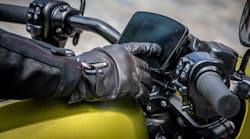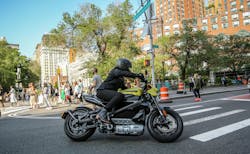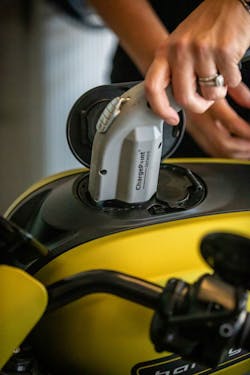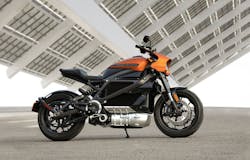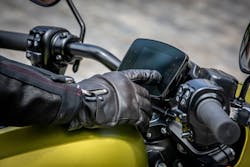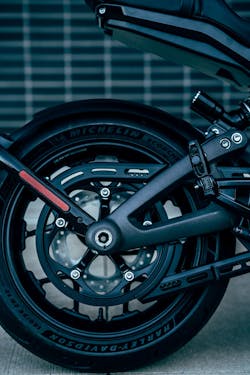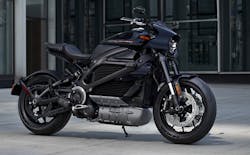Demographics move markets as companies constantly jockey to give the ever-changing public what it thinks they want. That’s one reason why iconic American motorcycle maker Harley-Davidson had its engineers design the LiveWire, an all-electric motorcycle they hope will lure new generations of riders to the open road.
The Powertrain
LiveWire gets its get-up-and-go from a 105-hp H-D Revelation motor. It pumps out 86 ft.-lb of torque and, unlike internal combustion engines, it produces 100% of its rated torque the instant the throttle is twisted (and it is always available, so passing is a breeze). The 553-lb bike accelerates from 0 to 60 mph in 3.0 sec. and then will take the rider to 80 mph in another 1.9 sec. Top speed for the $29,799 bike is electronically governed at 110 mph.
The motor is cooled by a water jacket, with coolant circulated through a small radiator.
The motor is positioned longitudinally and low in the chassis to lower the bike’s center of gravity to improve handling, maneuverability and braking. It mounts to the lightweight cast-aluminum frame as a stressed member to increase rigidity,
There is no traditional transmission or clutch. The motor’s output shaft mates to a gearbox with a 9.71:1 gear reduction running in an oil bath. A gearset then turns the rotational output 90 deg., aligning the drive belt sprocket with the rear wheel. A final-drive belt send power from the gearbox output pulley to the rear wheel.
The SHOWA BFRC rear shock is fully (manually) adjustable for pre-load (threaded adjuster with 11 turns and 16.8 mm of range), compression damping (4 turns) and rebound damping (4.5 turns). This lets riders fine-tune the rear suspension for different loads and road conditions. The Showa SFFO-BP front fork delivers low-speed damping for easy control during urban driving. Matched to the rear suspension, it is fully and manually adjustable for pre-load (20 turns and 20 mm of range), compression damping (7 turn range) and rebound damping (5.5 turn range). Brembo Monoblock front brake calipers gripping dual 300 mm-diameter discs are said to deliver outstanding braking power with a crisp feel.
Batteries and Recharging
The LiveWire motorcycle carries a 15.5 kWh high-voltage battery, or what Harley Davidson calls the Rechargeable Energy Storage System (RESS). It provides 140 miles of city range or 88 miles of combined stop-and-go and highway range.
The RESS consists of lithium-ion cells enclosed in a cast-aluminum housing which also acts as a heat-sink to cool the cells. The sides of the RESS housing are finned and exposed to the air and elements. Small air scoops on the bike’s bodywork duct cooling air to the upper portion of the RESS housing. The RESS housing attaches to the frame at several points and contributes to the chassis’ over-all rigidity.
A regulator rectifier powered by the RESS keeps the 12-V battery charged when the vehicle’s in operation.
The RESS has a five-year, unlimited-mileage warranty.
LiveWire is also equipped with a 12-V lithium-ion accessory batter for lights, controls, horn and instrument display; start-ups; and key fob recognition. This battery is significantly smaller than the RESS and is a Harley-Davidson Genuine Part available at dealers.
The RESS can be recharged using DC Fast Charge (DCFC) through a SAE J1772 connector or a CCS2 (an IEC type 2 charging connector common in Europe and some other countries). DCFC takes a battery from 0 to 80% capacity in 40 minutes or to 100% in 60 minutes.
All Harley-Davidson dealers selling the LiveWire will have a public DCFC charging station. Buyer get two years of free charging at participating dealers. Additionally, Harley will provide U.S. bike owners with 500 kWh of free charging at Electrify America DCFC charging stations.
The motorcycle comes with an on-board Level 1 charger that plugs into standard 120-V (or 240-Vt) household outlets with a special power cord that stores below the motorcycle seat (the bike’s only storage). It delivers 13 miles of driving time for each hour of charging or a full charge overnight.
The LiveWire motorcycle may be charged with a Level 2 charging station, but it will charge at the Level 1 rate. The charging port is located below a cap in the bodywork forward of the motorcycle seat.
The rider is also recharging the RESS when the bike is coasting off-throttle. That’s when the rear wheels run the motor as a generator, slowing the bike while generating electricity (regenerative braking). The rider feels the regeneration as engine-braking. If regenerative braking is strong enough, the rear brake light comes on.
Ride Control
LiveWire has seven selectable ride modes that electronically control the bike’s performance characteristics and the level of electronic intervention. Four modes are pre-programmed, and owners can tailor three more. Each mode has a setting for power (the maximum rate of acceleration), regeneration, throttle response and traction control.
Riders uses the MODE button on the right-hand controller to change the ride mode, and the active mode may be displayed as a widget symbol on a color touchscreen. The rider can change ride modes while riding the motorcycle or when stopped.
Sport Mode: Delivers LiveWire’s full performance potential of the motorcycle with full power and the quickest throttle response. Traction control gets set to its lowest level of intervention, and regeneration offers a significant off-throttle braking effect.
Road Mode: Delivers balanced performance for daily use, with Anti-lock Braking System (ABS) and Traction Control System (TCS) intervention that offers peace of mind. In this mode, the electric motorcycle is designed to respond like a conventional (for now) motorcycle.
Range Mode: Combines a judicious throttle response with a high level of regeneration to squeeze the most mileage out of a full charge.
Rain Mode: This mode offers restrained acceleration and limited regeneration with higher levels of electronic intervention. This should give riders greater confidence when riding in the rain or when traction is limited. Harley-Davidson says this mode is appropriate for beginners while they gain confidence with electric motorcycles.
Custom Modes: With the motorcycle off, the rider can create up to three Custom Modes, displayed as A, B, and C on the touchscreen mode widget. Custom Modes let riders select their own preferences for power, regeneration, throttle response and traction control levels within specific ranges. Power, regeneration and throttle response can adjust from 0 to 100% in 1% increments, while traction control can be set to low, medium or high.
Safety
LiveWire protects its rider with a hi-tech shield, the Reflex Defensive Rider Systems (RDRS), which matches the motorcycle’s performance to the available traction during acceleration, deceleration and braking. These electronic subsystems use the latest in chassis and brake control and powertrain technology.
Cornering Enhanced Antilock Braking (C-ABS) prevents the wheels from locking under braking and helps riders maintain control when braking in a straight-line or urgent situation. It operates independently on front and rear brakes to keep the wheels rolling and prevent uncontrolled wheel lock. C-ABS is a variant of ABS that takes into consideration the bike’s lean angle motorcycle. Brake pressure needed to limit wheel slip when cornering is typically lower than the pressure it takes when driving in a straight line.
Rear-wheel Lift Mitigation borrows the C-ABS sensors and six-axis inertial measurement unit to manage rear-wheel lift during heavy braking, while balancing deceleration and rider control.
Cornering Enhanced Traction Control System (C-TCS) keeps the rear wheel from “spinning out” when accelerating when cornier or going straight. C-TCS boosts rider confidences when available traction is compromised by wet weather, sudden unanticipated changes in the road surface and when riding on unpaved roads. C-TCS also takes account of lean angle when cornering. Each pre-programed ride mode has a specific level of C-TCS. In customizable ride modes, riders can select from three levels of C-TCS. Sider can always deactivate C-TCS when stopped, except in Rain Mode. C-TCS can also be re-activated with the push of a button on the left-hand control when the bike or underway.
Front-Wheel Lift Mitigation lowers the height and duration of front-wheel lift, which is tied to the rider-selected C-TCS mode. It is switched off when C-TCS is off.
Drag-Torque Slip Control System (DSCS) manages rear-wheel slip and prevents rear-wheel lock due to regenerative braking, which usually happens when riders decelerate on wet or slippery road surfaces. It operates at speeds over 10 mph and works with the ABS to balance motorcycle deceleration and rider control. DSCS is critical for rear wheel ABS performance.
A Daymaker LED headlamp gives riders a cleanly lit view of the road at night. LED signal, brake and tail lamps are bright day and night, and conspicuous in traffic.
Electronics and Connectivity
There are no dials. Instead a 4.3-in. color TFT touchscreen above the handlebar gives the rider a wide range of information on a bright and easy to read display. Harley made sure the water- and weather-resistant screen can detect the rider’s touch even if they are wearing gloves.
The display is tilt-adjustable to give riders the best viewing angle and the screen brightness adjusts automatically. The touchscreen only works when the motorcycle is not moving, but many display options can be changed by using joysticks while riding. Riders also control music and phone functions with the joysticks.
The screen always shows speedometer with speed, range and high-voltage battery status (percent remaining), as required by motor vehicle regulations. It can be customized by adding a power meter showing how much of the available power is being used as the motorcycle is being ridden, ride mode indicator, charge status and alert information keyed to turn signals (ABS, Traction Control and Check Engine/Battery Overheat, for example).
H-D Connect, a free service the first year, uses cellular telematics control unit as an LTE-enabled modem connecting LiveWire to the cloud.
Information available through H-D Connect includes high-voltage battery charge status, available range and battery charge status. So, while LiveWire is charging, owners can check the charge status, including charge level and time to completion, without having to be near the motorcycle. H-D Connect also tells rider where their bike is parked if the cellular signal is strong enough. It will send an alert to the owner’s phone if the security system is activated because the motorcycle has been bumped or is being tampered with. Another alert gets sent to the owner’s phone if the motorcycle is moved out of the geo-fenced area. If the worst happens, GPS-enabled stolen-vehicle tracking provides peace of mind should the owner need to locate their motorcycle.
Making it Easy
Electric power requires no clutch and no gear shifting, simplifying operation for new riders. Maintenance is also easy. The electric powertrain eliminates most routine maintenance: There’s no engine oil to change, no spark plugs or air filter, and no issues with ethanol-blend gasoline and off-season storage. It still requires inspection or service of some mechanical and consumable items, such as the drive belt tension, gearbox oil, brake fluid and brake pads, and tires.
The electric powertrain also generates minimal vibrations, very little heat and is not that loud. There is some “noise,” but it was designed in.
When rider turn the LiveWire on, the motor emits a subtle pulsing of torque to let the rider know the bike is ready to hit the road. The sound is supposed to mimic a human heartbeat at rest and give the owner an emotional connection to the bike. The pulsing ceases when the motorcycle moves and resumes when it comes to a stop. It can turned on or off by the dealer, depending on owner preference.
The motorcycle also produces a mechanical signature Harley-Davidson sound that increases in pitch and volume with speed.
LiveWire is the halo of H-D's EV portfolio. It will be followed by lighter, smaller and even more-accessible electric motorcycles over the next 2 to 4 years designed to inspire new riders with new ways to ride. Harley-Davidson recently showed off two its lightweight electrified concept bikes at the Consumer Electronic Show. It also has prototype Harley-Davidson-branded two-wheeled electric bike for kids (children ages 3 and older and less than 75 lb). It is the result of a recently reported acquisition of most of StaCyc Inc.’s assets.
Making “personal expression more accessible and individualized” is the key to Harley-Davidson’s strategy to grow the next generation of motorcycle riders globally, and is a component in the company’s vision of urban mobility’s future.
